
|
|
 |

|


|
Sony 46HX820 Review
46" Edge-lit LED LCD 3D HDTV, $2599
Out of the Box
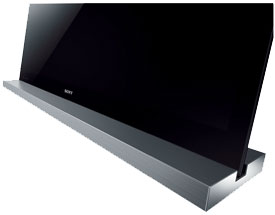
The outward appearance and styling of the HX820 is similar to earlier "monolithic" models with the glass on the front stretching from edge to edge with no frame around it. Underneath is a black bezel that is 1 1/4" wide on the top and sides and 2 1/4" on the bottom.. For a particularly stylish flair, you can slot the display in a silver base (sold separately). Or you can attach the TV on its stand leaning slightly backwards, (six degrees) which gives you a better viewing angle when the TV is placed below where you are sitting. Also, the TV can swivel on its stand 20 degrees left or right, which allows for more flexibility in locating it. 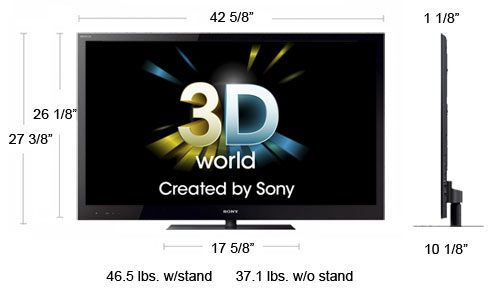 The front of the TV only has a few operational lights on the bottom left edge. The control buttons are inset behind the screen along the right edge of the TV. On the back of the left side, aligned vertically, is one of two connection panels. At the top are two USB ports for accessing photo, music, video files stored on a USB device. Moving down the line, Sony furnishes two HDMI connections. Below them is an Audio Out mini-jack and a digital Audio Out (optical). At the bottom is a VGA PC input (with a matching stereo Audio In minijack). The second panel is aligned horizontally and its connectors are facing down, which makes them harder to see and reach.  Starting on the left is a LAN connection if you wish to attach this TV to your home network with an Ethernet cable. As I mentioned, the HX820 also has an integrated wireless adapter if you prefer to run free. The one RF antenna connector links to integrated ATSC/QAM tuners. Since the tuner system is Clear QAM compatible, you can attach your cable TV signal directly into the RF connector and tune in unscrambled cable stations. With the ATSC tuner and the proper antenna, you also will be able to tune in digital signals broadcast over-the-air. Next on the panel is a customized input that connects to a supplied adapter cable. With this setup, you can either plug in a component or composite video signal with stereo audio. Rounding out the inputs are two more HDMIs, (labeled 1 and 4). The manual states, "If connecting a digital audio system that is compatible with Audio Return Channel (ARC) technology, use the HDMI IN 1 on the rear of the TV. If not, an additional connection with DIGITAL AUDIO OUT (OPTICAL) is necessary." 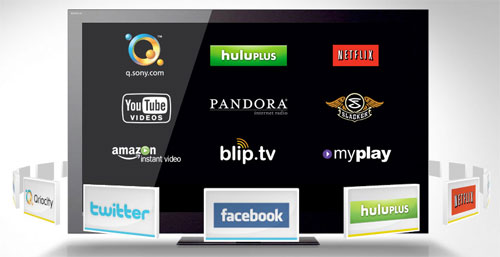 Sony is constantly expanding and honing its lineup of content providers. Currently, under the BRAVIA Internet Video banner, they offer 44 sources of streaming video and music. Social media apps like Facebook, twitter and Flickr are included as widgets that pop up over the screen. Sony has also implemented its own video on demand service titled Qriocity, which is a rental model similar to Amazon's. For the 3D enthusiasts waiting for more content, Sony recently launched "3D Experience" an almost constantly updated collection of movie trailers, sports footage and other 3D material. The HX820 is also DLNA Certified. When attached to your home network, the TV can access videos, photos and music stored on your DLNA Certified computer or other compliant devices and play the content directly on to your HDTV. The one major hiccup that I encountered was trying to display still images on this TV, either from an attached USB drive or through the home network. The HX820 seems to be very persnickety about the makeup of JPEG images. For example, I plugged in a flash drive full of JPEGs into the TV's USB port. The TV recognized the drive and identified the files, but when I tried to play them, the message "Image cannot be viewed" appeared. I have played this drive with these exact images on a number of different TVs and Blu-ray players without a problem, therefore I was perplexed and inquired with a Sony rep. Tech Support responded with an explanation that included, "The photo uses 1x1 or YCbCr 4:4:4. No Chroma subsampling compression was used." And concluded with, "JPEG pictures which could be from photo editors like Photoshop, flatbed scanners, or pictures taken with high end cameras will not display on 2011 DTVs. These JPEG pictures may contain additional color data which is incompatible with the TV's microprocessor." Finally, the suggestion was, "Resave the original jpg to another file using a quality setting of 5 or lower (or half of the quality adjustment range) in the picture/photo editor of choice." I took the advice and the images showed up. Of course, this is not a great solution for avid photographers who want to see their pictures displayed at the highest quality. Also, it begs the question, why? What has changed from last year's Sony TVs? And why will the flash drive play just fine when I plug it into this year's Sony Blu-ray player? It's a shame because I like the slideshow interface. You can even apply a 2D to 3D conversion to the photos. 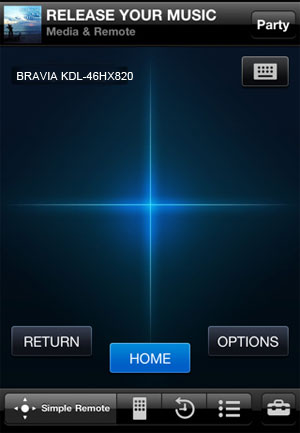
Two of the most notable other extras are Skype compatibility (with the purchase of a $150 camera and microphone) and a free Media Remote app for your iPhone or Android phone. I actually downloaded it to my iPad and it worked as advertised. I find it especially useful when searching for talking dog videos on YouTube. Rather than fumbling with the TV remote to type in search terms, I can use the QWERTY keyboard on the iPad. Before I leave this section, I must take issue with the Distance Alert feature that warns you if a child is too close to the TV. (Though the manual states that it may not work if your tyke is running towards the TV.) I was watching the semifinals of the women's FIFA world cup when I must have triggered the alert, which replaces the broadcast with a warning message, which you then have to disengage by punching a number of buttons. Luckily, there was a lull in the action or I might have Abby Wambached the HX820 with a striking header. I controlled myself, which was fortunate for my noggin because this TV is protected with Corning's tough Gorilla Glass. On a related note, the Distance Alert is tied in with the Presence Sensor feature, which does just that. To see it in action go into the Preferences menu, you'll find the Position Control option, which "Optimizes picture and sound by detecting the viewer's position." Open it up and lo and behold on the interface is a fuzzy little video screen of you looking at the TV. If you sit still for a few moments, a white rectangle will outline your face. To me, the whole process is a little disturbing - a bit too big brotherish. But to be fair, the system cannot only adjust audio and video, it can also turn off your TV if nobody is in the room, which saves energy. And if you feel uneasy about your TV looking back at you, you can deactivate all the presence sensor functions. 
The multi-function remote control is one of the longest, most capacious that I have handled. I like the dedicated buttons that take you directly to menus like Internet Video and Qriocity. For those of you that aren't ticked at Netflix for their new pricing, the remote has added its own button. One of your best friends is the multi-purpose Options button which provides a quick shortcut to context sensitive menus. If you punch the Light button on the remote, a blue backlight glows around all the buttons. The designers also added an uncommon twist. They put a second On/Off button on the back of the remote - there's still the traditional one on the front. As you can begin to see, the HX820 is a fully featured TV that will take some time to explore. For more information on all of the TV's functions, Sony offers an on-screen i-Manual that you can access by hitting the i-Manual button on the remote. It's still not highly detailed, but it does a reasonable job of giving most consumers all the knowledge that they need to get up to speed. Sony on their website also posts the i-Manual. Power Consumption
The EPA is now publishing a list of ENERGY STAR qualified TVs. (You can find it here.) The Sony KDL-46HX820 is on the list. 
The EPA states that this Sony's On Mode Power is 75W and Standby Power Consumption is .09W. Based on the formula that the TV is on five hours a day and in Standby for the other 19, the Estimated Annual Energy Use is 144 kWh/year. The Federal Trade Commission (FTC) now requires those yellow-and-black labels that show the product's estimated annual energy cost to be attached to all TVs. 
Sony displays that label on their SonyStyle site. You can see that the 46" HX820 fares quite well against its similarly sized competition. In addition, on the right side of the TV is an Energy Saving Switch. As you can see in the ratings, even in Standby Mode, the TV is sipping a little bit of energy, which if you multiply by millions of TVs can add up. If you flip the Energy Saving Switch, the unit totally powers down and draws no electricity. You need to flip it back On before you can power up the TV with the remote control. Setup
The basic setup of the 2011 HX820 has not changed significantly from last year's models. In the Initial Setup, you will answer basic questions like what is your zip code and then scan for your TV channels and your Network connections. Sony does a good job of making this process automatic and unless you have some unusual network configuration, you should be connected in a matter of minutes. As a matter of fact, I plugged in a network cable to the LAN port and before I had a chance to deal with network setup, the TV was already connected. If you go wireless, the process may not be as automatic. After you are hooked up, you still will have some housekeeping chores. To take full advantage of all the available Internet content, you should go into the Settings menu and then the Network sub-menu and Refresh the Internet Content. And if you wish to tap into Netflix or Amazon Video on Demand or some of the other Internet content partners, you will need to set up an account with them. For example, with Netflix you need to subscribe to their service and register your HX820 at their site. If you plan on accessing your DNLA computer, you need to set up permissions for your TV in Windows. As for calibrating the TV, I suggest that most of you will be satisfied with simply turning the TV on, setting the Picture Mode to Standard and forgetting it. The Sony engineers have done a fine job of presetting the Picture modes to display a highly respectable image. 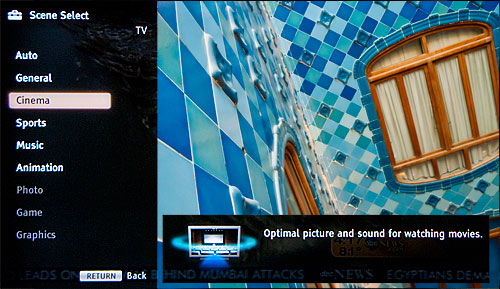 If you are more venturesome or just wish to explore more options, then go into the Scene menu and try the different choices, paying particular attention to Cinema. Believe me, after running through my standard setup procedure with three calibration Blu-ray discs, my final settings mirrored Cinema very closely. If you feel the itch to tweak, Sony provides you with a good tool chest. But for many of you, your time will be better spent exploring the various Internet content apps and widgets that this Sony has to offer. The HX820 has Motionflow PRO 480 technology, which basically means that the panel has a 240Hz refresh rate though with a extra step called backlight blinking,it can generate 480 "scenes" a second, rather than the standard 60. (You can read more about the concept here.) The theory is that generating the extra frames will smooth out fast action. In practice, personally, the increased frame rate has a tendency to make the image too sharp. To my eye, especially when watching movies, I prefer the softer image that the TV produces when Motionflow is turned off. I suggest that you experiment with different combinations of Motionflow and CineMotion to see which you prefer. I tend to leave Motionflow off and CineMotion at Auto 1. |
Bookmark:
![]() del.icio.us
del.icio.us
![]() Reddit
Reddit
![]() Google
Google
Reader Comments
| Send this Page | Print this Page | Report Errors |


Posted Mar 25, 2015 5:25:58 AM
By Dave Linge